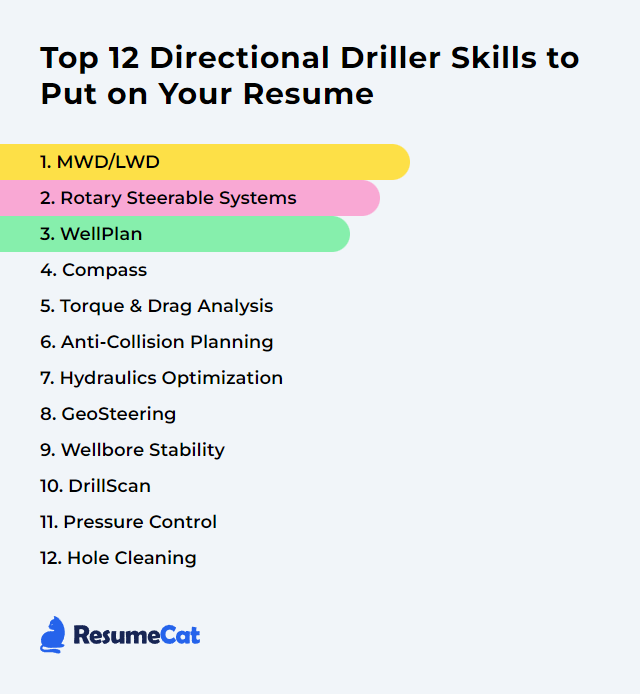Top 12 Directional Driller Skills to Put on Your Resume
In the highly specialized world of directional drilling, the skills you highlight can swing doors open. Precision matters. Speed matters. Sound judgment when the hole starts misbehaving matters even more. The 12 skills below anchor your value in the field—practical, measurable, and tuned to modern drilling realities.
Directional Driller Skills
- MWD/LWD
- Rotary Steerable Systems
- WellPlan
- Compass
- Torque & Drag Analysis
- Anti-Collision Planning
- Hydraulics Optimization
- Geosteering
- Wellbore Stability
- DrillScan
- Pressure Control
- Hole Cleaning
1. MWD/LWD
MWD (Measurement While Drilling) and LWD (Logging While Drilling) deliver real-time downhole data—inclination, azimuth, toolface, gamma, resistivity, density, sonic, and more. With that stream, you steer accurately, confirm pay, and keep the well on plan without guesswork.
Why It's Important
Real-time telemetry underpins directional control and formation evaluation. It sharpens well placement, reduces non-productive time, flags hazards early, and keeps the bit in the money zone.
How to Improve MWD/LWD Skills
Sharpen the signal, sharpen the outcome. Practical focus areas:
Data quality first: Calibrate sensors, validate survey quality, and apply robust noise filtering. Bad inputs poison decisions.
High‑bandwidth telemetry: Optimize mud-pulse settings, consider EM in suitable formations, and leverage wired drill pipe where available for richer, faster data.
Integrated workflows: Fuse MWD/LWD with drilling parameters, geomechanics, and offset data. Build a single pane of truth for the team.
Predictive analytics: Use models to anticipate toolface response, BHA tendencies, and formation changes before they blindside you.
Training and drills: Rehearse abnormal situations—telemetry dropouts, survey conflict, sensor drift—so responses are swift, not improvised.
Preventive maintenance: Rigid pre-job checks and service intervals cut failures and free trips.
Do that well, and the bit goes where you want it—fast.
How to Display MWD/LWD Skills on Your Resume
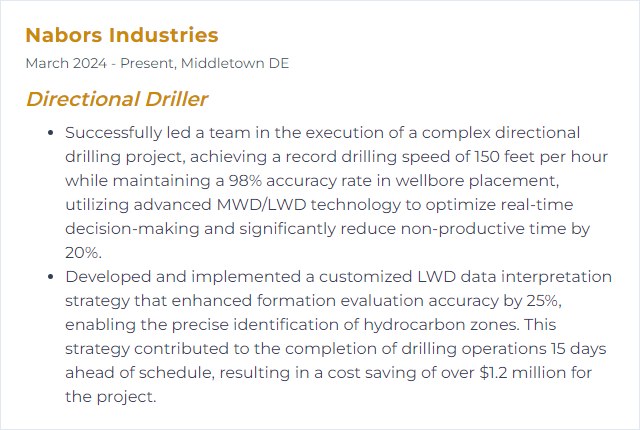
2. Rotary Steerable Systems
RSS delivers continuous rotation with precise steering—push-the-bit or point-the-bit—limiting slide time, lowering tortuosity, and unlocking smoother laterals with cleaner hole.
Why It's Important
Accuracy jumps. Drilling time falls. Wellbore quality improves, which pays off in casing, completions, and production.
How to Improve Rotary Steerable Systems Skills
Trajectory discipline: Set clear dogleg, build/turn, and smoothing targets; monitor separation factors in congested fields.
Real-time tuning: Track toolface response, vibration, and channel health; adjust weight on bit, RPM, flow, and steering aggressiveness proactively.
BHA design: Balance stiffness, stabilizer placement, bit selection, and motor/RSS compatibility to meet planned DLS without chatter.
Event prevention: Use surface and downhole vibration monitoring to curb stick-slip, torsional oscillation, and whirl.
Post-well learnings: Close the loop—actual vs. planned, tendencies by formation, and tool-specific quirks.
How to Display Rotary Steerable Systems Skills on Your Resume
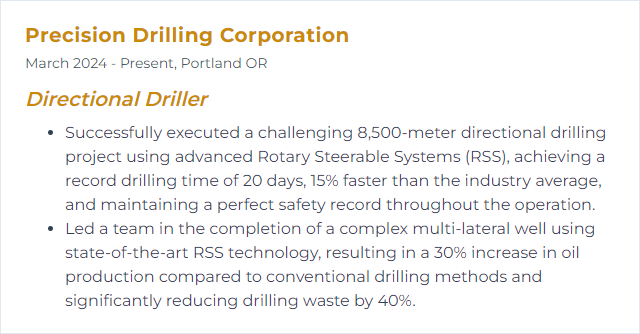
3. WellPlan
WellPlan is engineering software commonly used for hydraulics, torque & drag, casing wear, and related models. It helps you design, verify, and adjust parameters with physics rather than hunches.
Why It's Important
The right settings protect the hole, the string, and the schedule. WellPlan turns offset lessons into actionable operating windows.
How to Improve WellPlan Skills
Use current inputs: Keep fluids, BHAs, bit nozzles, flow rates, and surveys updated. Stale data breaks predictions.
Model both static and dynamic: Account for ECD, surge/swab, cuttings loading, and rotation effects in high-angle sections.
Scenario planning: Pre-run contingencies for losses, tight spots, higher DLS, and temperature shifts.
Validate against reality: Compare modeled vs. actual standpipe pressures, torque, and pick-up/slack-off trends; adjust friction factors and assumptions.
Team alignment: Share model limits and critical thresholds so the rig reacts quickly when trends drift.
How to Display WellPlan Skills on Your Resume
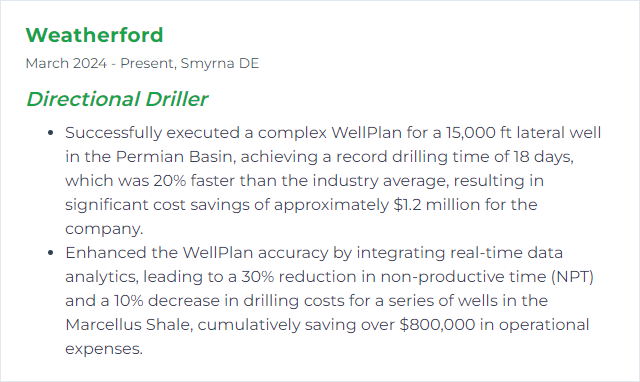
4. Compass
Compass typically refers to COMPASS well planning software used for trajectory design and anti-collision management. Not a handheld instrument—this is the planning backbone for complex pads and crowded fields.
Why It's Important
Accurate plans, clean surveys, and safe spacing keep your well on target and away from neighbors. That protects assets and licenses to operate.
How to Improve Compass Skills
Solid inputs: Use high-quality surveys and proper error models. Garbage in, risky plans out.
Anti-collision rigor: Apply separation-factor criteria, understand uncertainty ellipses, and document relief-well considerations if required.
Constraint-aware design: Honor build/turn limits, BHA capability, and formation tendencies. Don’t plan what you can’t drill.
Version control: Track plan revisions and tie them to operational decisions so everyone is literally on the same page.
Field feedback: Fold in lessons from actual steering performance to refine future plans.
How to Display Compass Skills on Your Resume
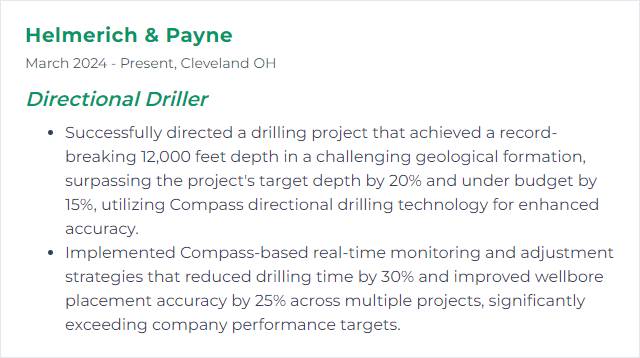
5. Torque & Drag Analysis
Torque & drag modeling predicts surface torque, pick-up, slack-off, and block weight trends as the string snakes through the path. It guides friction management and helps avoid stuck pipe and equipment damage.
Why It's Important
Expectations set early flag trouble fast. If measured values drift from the model, you act before the string stalls or twists apart.
How to Improve Torque & Drag Analysis Skills
Precise trajectories: Model with actual surveys and realistic tortuosity, not just plan points.
Right friction factors: Calibrate by section and mud system; update when hole conditions change.
Real-time comparison: Track torque/drag trends live. Deviations are warnings—reduce cuttings beds, change parameters, or ream as needed.
Optimize practices: Manage weight transfer, rotation in high-angle hole, and wiper trips judiciously.
BHA choices: Stiffness, stabilizer placement, and jars can transform outcomes in long laterals.
How to Display Torque & Drag Analysis Skills on Your Resume
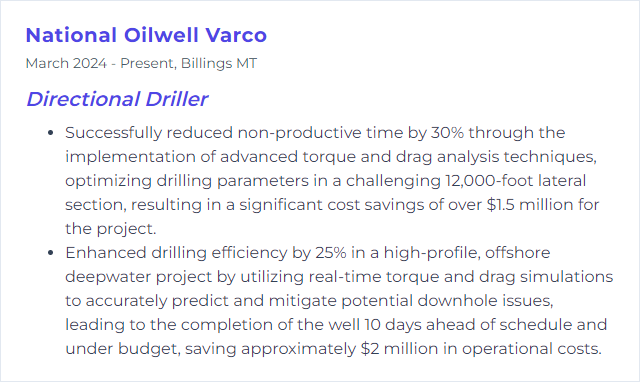
6. Anti-Collision Planning
Anti-collision planning designs and executes well paths that respect clearances to nearby wells using survey uncertainty and separation-factor criteria.
Why It's Important
Collisions are catastrophic—safety, environment, production, reputation. Good planning makes them vanishingly unlikely.
How to Improve Anti-Collision Planning Skills
Error models matter: Apply appropriate survey error models and keep them consistent across wells in the grid.
Separation factors: Use conservative thresholds in congested pads and complex geology; document exceptions and approvals.
Live monitoring: Compare real-time surveys against the reference network and trigger holds if separation erodes.
Governance: Pre-job reviews, formal risk assessments, and clear escalation rules keep discipline tight.
Communication: Share collision risk plots with all stakeholders—no surprises when sliding near offsets.
How to Display Anti-Collision Planning Skills on Your Resume
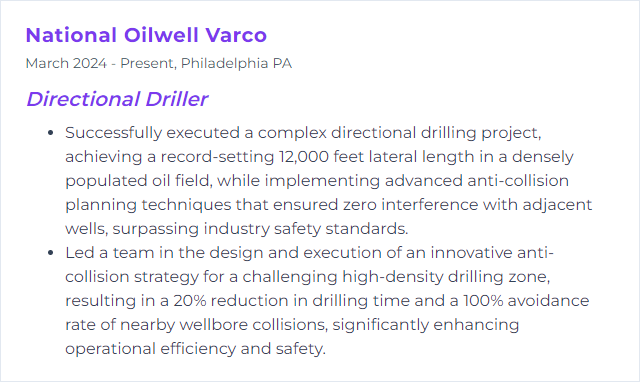
7. Hydraulics Optimization
Hydraulics tuning balances cuttings transport, bit cleaning, ECD control, and equipment limits. The goal: enough hydraulic horsepower at the bit and the right annular velocities without breaking the formation or the budget.
Why It's Important
Efficient cuttings removal lifts ROP, protects the wellbore, and minimizes torque and drag. Poor hydraulics quietly wrecks everything.
How to Improve Hydraulics Optimization Skills
Right mud properties: Dial in density, viscosity, and gels for transport and stability; adjust for temperature and solids loading.
Nozzle strategy: Select sizes for optimal pressure drop and cleaning without starving the annulus.
Manage ECD: Track standpipe pressure, flow, and cuttings load; avoid losses and ballooning by tuning pumps and RPM.
Model and verify: Run hydraulics scenarios pre-job, then compare to measured values; tweak as reality shifts.
Real-time visibility: Use continuous monitoring to catch early warning signs—rising trends, pressure hysteresis, pack-offs.
How to Display Hydraulics Optimization Skills on Your Resume
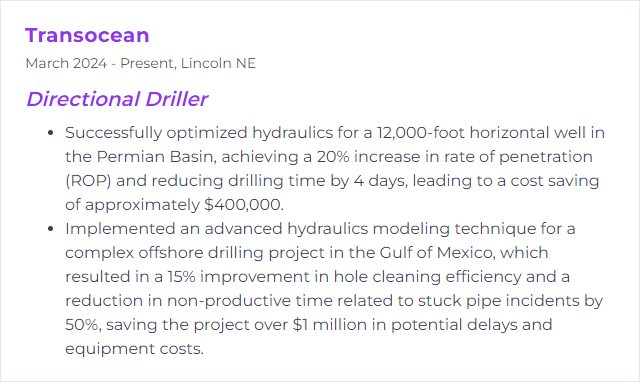
8. Geosteering
Geosteering is the real-time choreography of the wellpath using LWD measurements to stay in the sweet spot—navigating bed dips, faults, and fluid contacts while drilling.
Why It's Important
Better contact with reservoir quality rock means better wells. Miss the target and production pays the price.
How to Improve Geosteering Skills
High-quality LWD: Use reliable gamma, resistivity (including deep directional where possible), and image logs for structure and boundaries.
Rapid interpretation: Visualize data in 3D, track strat ties, and update structural models on the fly.
Clear decision rules: Define when to hold, drop, or turn before spud; avoid indecision when data shifts.
Tight team loop: Keep geologists, petrophysicists, and drillers in continuous contact—no lag between observation and action.
Post-well reconciliation: Compare actual to prognosis and refine look-ahead models for the next hole.
How to Display Geosteering Skills on Your Resume
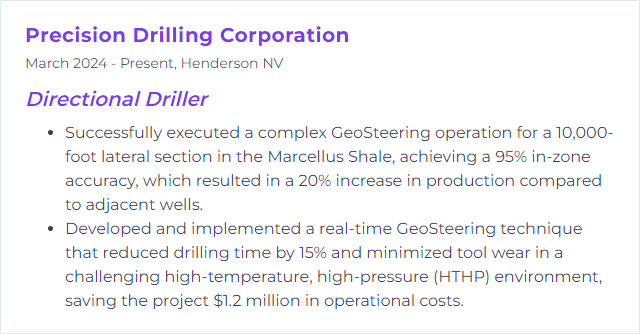
9. Wellbore Stability
Wellbore stability means the hole holds shape without collapsing, sloughing, fracturing, or ballooning. In deviated wells through reactive shales or stressed rock, that’s a daily fight.
Why It's Important
Instability breeds stuck pipe, losses, poor logs, and sidetracks. Stability preserves time and money—and safety.
How to Improve Wellbore Stability Skills
Geomechanics literacy: Understand in-situ stress, pore pressure, rock strength, and failure criteria. Know your mud-weight window.
Fluids that protect: Use inhibitive systems, proper salinity, and plugging materials in troublesome intervals.
Manage ESD/ECD: Control surge/swab, ramp pumps sensibly, and avoid aggressive RIH/POOH that destabilizes fragile zones.
Trajectory choices: Align wellpath with stress orientation where possible; tame DLS in weak formations.
Watch the signs: Shale cavings, torque spikes, drag trends, and flow anomalies are messages—act quickly.
How to Display Wellbore Stability Skills on Your Resume
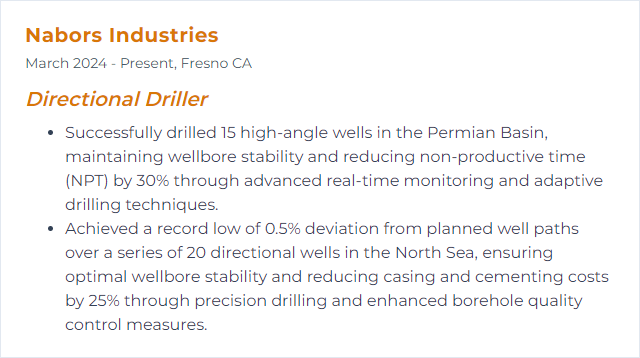
10. DrillScan
DrillScan refers to drilling engineering software and services focused on drillstring mechanics, BHA behavior, vibration, and trajectory integrity. It helps predict critical speeds, bending stress, whirl, and other failure modes before they bite.
Why It's Important
Insight into the mechanics behind the metal cuts failures, smooths torque, and boosts ROP without flirting with damage.
How to Improve DrillScan Skills
Keep it current: Run the latest versions and modules; new releases often improve modeling fidelity.
Feed good data: Accurate string makeup, material properties, stabilizer placements, bit parameters, and boundary conditions are non-negotiable.
Couple with real-time: Compare predicted vibration and torque with downhole and surface measurements; tune RPM and WOB to dodge criticals.
Iterate BHAs: Use what-if scenarios to test stabilizer spacing, string stiffness, and jar placement for the planned DLS and lithology.
Capture lessons: Build a library of field-proven configurations by basin and formation.
How to Display DrillScan Skills on Your Resume

11. Pressure Control
Pressure control is the art and discipline of keeping bottomhole and annular pressures where they need to be—preventing influxes and losses while drilling efficiently.
Why It's Important
Safe operations depend on it. Blowout prevention, wellbore stability, and rate all ride on proper pressure management.
How to Improve Pressure Control Skills
Watch the indicators: Flow checks, pit volumes, trends in standpipe pressure, cuttings character—treat small anomalies seriously.
MPD where warranted: Managed Pressure Drilling techniques tighten the annular profile and can safely thread narrow windows.
Mud system mastery: Tune density and rheology; maintain properties under temperature and contamination swings.
Procedure discipline: Practice shut-in drills, choke operations, and handover protocols until they’re muscle memory.
Equipment readiness: Test and maintain BOPs, chokes, manifolds, and sensors; verify before the hole gets spicy.
How to Display Pressure Control Skills on Your Resume
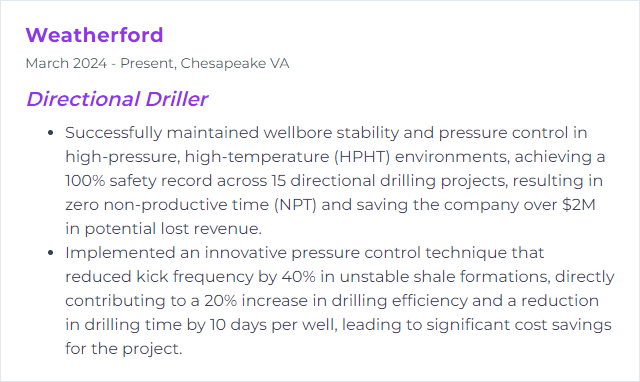
12. Hole Cleaning
Hole cleaning is the steady removal of cuttings from the annulus, especially tricky in high-angle and horizontal sections where beds love to build.
Why It's Important
Poor cleaning jacks up torque, drags ROP down, causes pack-offs, and traps strings. Good cleaning keeps the well moving.
How to Improve Hole Cleaning Skills
Right annular velocity: Set flow rates to exceed slip velocity in each section; revisit when density or viscosity changes.
Leverage rotation: Use drillpipe RPM to agitate beds in deviated hole; manage RPM to stay clear of vibration hazards.
Mud that carries: Tune viscosity and gels for suspension during pumps-off and transport during circulation. Temperature matters.
Sweeps and spacing: Time high-vis or weighted sweeps strategically; add agitators or subs where beneficial.
Geometry awareness: Plan trajectories and DLS to reduce bedding hotspots; ream and backream when trends hint at trouble.
How to Display Hole Cleaning Skills on Your Resume

